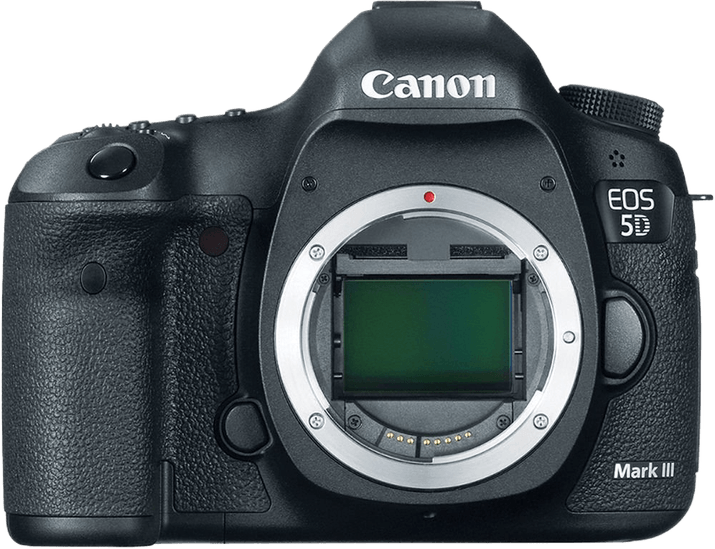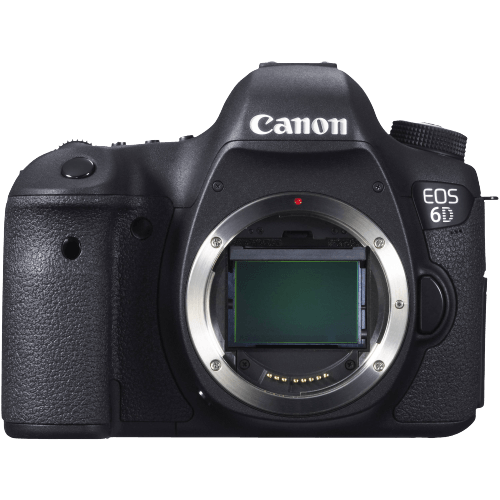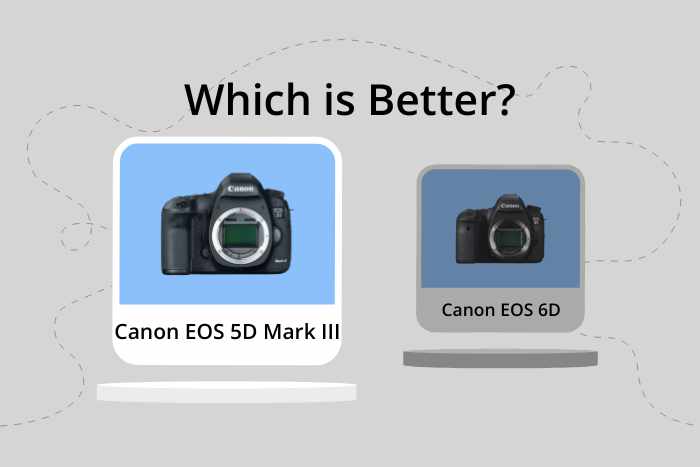Canon EOS 5D Mark III vs EOS 6D Comparison
Canon EOS 5D Mark III

Canon EOS 6D

The Canon EOS 5D Mark III outperforms the Canon EOS 6D with a score of 65/100 versus 59/100. Both cameras are DSLRs released in 2012 and share some similarities. They have the same sensor size and resolution, and both support RAW file format.
The 5D Mark III excels with a more advanced autofocus system, better continuous shooting speed, and a higher maximum shutter speed. These features make it an excellent choice for professional photographers.
On the other hand, the 6D has a smaller body, weighing 770g compared to the 5D Mark III’s 950g, making it a more portable option. Additionally, the 6D is significantly cheaper, with a launch price of $2099 versus $3499 for the 5D Mark III.
Weighing the pros and cons, the Canon EOS 5D Mark III is the superior choice for professionals, while the Canon EOS 6D may be more suitable for hobbyists or those on a tighter budget.
Canon EOS 5D Mark III vs EOS 6D Overview and Optics
The Canon EOS 5D Mark III wins in the optics comparison with a score of 67/100, while the Canon EOS 6D scores 61/100. Both cameras share several specifications, including sensor type (CMOS), processor (Digic 5+), sensor size (Full Frame), lens mount (Canon EF), and the absence of image stabilization.
The 5D Mark III outperforms the 6D in terms of megapixels and shooting speed. With 22.3 megapixels, the 5D Mark III captures more detailed images compared to the 6D’s 20.2 megapixels. Additionally, the 5D Mark III has a faster shooting speed of 6 frames per second, while the 6D captures images at 4.5 frames per second. These advantages make the 5D Mark III more suitable for photographers requiring higher resolution and faster shooting capabilities.
On the other hand, the 6D has a slightly higher DXOMARK score for the sensor, with a score of 82 compared to the 5D Mark III’s 81. This indicates that the 6D’s sensor may perform marginally better in certain situations, such as low-light conditions. However, this slight advantage does not significantly impact the overall performance of the camera in terms of optics.
Considering the differences in optics, the Canon EOS 5D Mark III is the superior choice due to its higher megapixel count and faster shooting speed. While the 6D has a marginally better DXOMARK score, this advantage is not enough to outweigh the benefits of the 5D Mark III. Photographers looking for higher resolution and faster shooting capabilities should opt for the Canon EOS 5D Mark III.
Canon EOS 5D Mark III vs EOS 6D Video Performance
The Canon EOS 5D Mark III emerges as the winner in the video capabilities comparison with a score of 56/100, outperforming the Canon EOS 6D, which has a score of 43/100. Both cameras share some video specifications, such as having a maximum video resolution of Full HD and dimensions of 1920 x 1080. Additionally, neither camera has built-in time-lapse functionality.
The 5D Mark III’s video performance surpasses the 6D due to its higher maximum video frame rate of 60fps, which is double the 6D’s 30fps. This higher frame rate allows for smoother video playback and offers more flexibility when it comes to slow-motion effects in post-production.
On the other hand, the Canon EOS 6D does not have any distinct advantages over the 5D Mark III in terms of video capabilities. Its lower video score and frame rate limit its potential for professional video production.
Taking these factors into account, the Canon EOS 5D Mark III is the better choice for videographers who require smoother, more versatile video recording options. The Canon EOS 6D, while still a capable camera, does not offer any advantages in video capabilities when compared to the 5D Mark III. Therefore, those looking to prioritize video performance should opt for the Canon EOS 5D Mark III.
Canon EOS 5D Mark III vs EOS 6D Features and Benefits
The Canon EOS 5D Mark III outperforms the Canon EOS 6D with a feature score of 59/100 compared to the 6D’s 57/100. Both cameras share some common specifications, such as a screen resolution of 1,040,000 dots, a lack of touchscreen, and absence of a flip screen. Neither camera has Bluetooth capabilities.
The 5D Mark III excels with a larger screen size of 3.2 inches, which improves the user experience by providing a more comfortable view of images and menus. This advantage is significant, as photographers often rely on the camera’s screen for reviewing and composing their shots.
On the other hand, the Canon EOS 6D offers GPS and Wi-Fi functionalities, which the 5D Mark III lacks. These features allow photographers to geotag their images and transfer files wirelessly, simplifying the process of sharing and organizing photos. The 6D’s inclusion of these convenient features gives it an edge in terms of connectivity and location-based photography.
Taking these factors into account, the Canon EOS 5D Mark III is the superior camera in terms of screen size, providing a better viewing experience for photographers. However, the Canon EOS 6D offers more advanced connectivity features, which may appeal to those who prioritize convenience and location-based capabilities. Ultimately, the choice between these two cameras depends on the individual photographer’s preferences and needs.
Canon EOS 5D Mark III vs EOS 6D Storage and Battery
The Canon EOS 5D Mark III triumphs in storage and battery with a score of 76/100, while the Canon EOS 6D lags behind at 45/100. Both cameras share the LP-E6 battery type and neither has USB charging capabilities. They also accept SD, SDHC, and SDXC memory cards.
The 5D Mark III outshines the 6D with its dual memory card slots, allowing for more storage flexibility and backup options. It also supports Compact Flash and UDMA cards, providing additional storage choices. In contrast, the 6D only has a single memory card slot and lacks support for Compact Flash and UDMA cards.
Despite its lower score, the 6D does have a longer battery life, offering 1090 shots compared to the 5D Mark III’s 950 shots. This advantage may benefit users who prioritize extended shooting time without needing to swap batteries.
Taking these factors into account, the Canon EOS 5D Mark III stands as the superior choice for storage and battery capabilities due to its dual memory card slots and broader card compatibility. However, the Canon EOS 6D may still appeal to those who value longer battery life.
Canon EOS 5D Mark III vs EOS 6D Alternatives
Still not ready to make a decision? Check out our other popular camera comparisons for inspiration:

